#bipedal gait
Text




The Scavenger spine has a strict curve that is difficult to stretch for long periods of time. This, paired with their short hind legs, meant scavenger evolution shied away from bipedalism in favor of developing strong hands-free carrying styles such as specialized spines for object collection, saving their heaviest tool use for sitting positions or single hand use.
The modern Scavenger has developed a compromise: Nearly all scavengers make use of a personal walking staff as a supportive tool, freeing at least one hand for use while mobile, either by swinging their lower body forward in short jumps or a much slower bunny-hop gait. They can stretch upright for short periods, but heavily prefer to maintain a forward arch- and thus favor clothing and fabric that is loose and flexible for easy switching (Although short frilled or trimmed scavengers can enjoy a good t-shirt).
They're very WIP and not very anthro... but maybe thats just cause slugcats are already walking around on two legs like that... its so easy
#ask#rain world#rw anthro#this is more like the evolution of the rw anthro scav than how they actually look lmao#but basically they can stand up right but its not how they /like/ to stand#and almost all of them use walking staffs as support for their legs and back
666 notes
·
View notes
Text
I just drafted all of this then lost it I'm going through a wall
Finished murderbot concept!!!

With bonus version with clothes 🎉
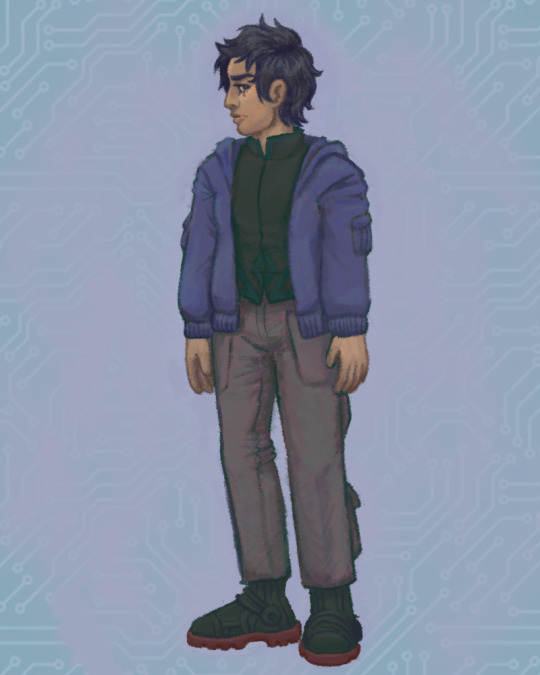
I have been making a lot of art lately (this is because I am procrastinating other things 😶)
Explanations below the cut (there was going to be a video but tumblr decided to fuck that)
So I have this old post about some head cannons for MBs appearance, but doing this full body design involved more thinking
I find it interesting that MB really only ever describes it's appearance when it's relevant to the plot/fight/scene, so anything that isn't relevant is left to our imagination. That being said:
MB says all it's inorganic parts are covered by a long sleeve shirt with a collar, pants and shoes. This means no inorganic parts on its face or hands
MB says it has no organic parts on its feet.
Slightly deeper cuts but MB mentions that it has inorganic and organic parts around its knees (I believe in exit strategy) and that it has an accessible company under its ribs (artificial condition)
People are often surprised when they see MB out of armor -- people who aren't familiar with secunits don't expect it to look as human as it does
MBs skin is canonically clear af (network effect I think)
Based on those handful of canon details, you can imagine Mb a lot of different ways -- this is great! And I've said before I think Martha Wells does this very much intentionally. So, that being said, here is some of my thoughts in this interpretation:
Based on that last point, MB looks surprisingly human. For me, this means soft facial features, eyelashes, and more organic parts than you might expect. Also, the inorganic parts are also round and nice looking -- this is partly just me thinking in a fun sci-fi way but also secunits are designed to be comforting
I've seen some people give it mechanical legs that are kind of bird-like or resemble running prosthetics. I think this is super cool and it makes a lot of sense-- those legs are basically a better form of bipedalism and let you run faster etc. BUT they would significantly change your gait. And thus be something MB considers when it is trying to pass as human. So I gave it more human feet, with the important toes and everything
I'm no expert on robotics or anatomy, but I really tried to think a little bit functionally. How would a secunit fold? How would it bend over, squat down, etc? I tried to give the look of some kind of shock system in the ankles, and conical-axis based joints. the hip area is probably the weak point in my design in this areas, idk, imagine ball bearings or something
For clothes, it's pretty straightforward. MB describes this more than a few times, but I tried to give some slightly fun sci-fi decoration bits
I tried to think about how androgyny might be generated in a silhouette in an unintentional way -- androgyny that is the result of functional design decisions and not aesthetic ones.
Idk. I had a lot of fun with this. This took about 4 hours (I've been trying not to overwork stuff lately and let the process show through) I might try and post the speed-draw video later? As a reblog perhaps. Idk Tumblr didn't like it the first time
Also a girl on bumble mentioned reading all systems red and I had to act so normal
#you have to understand these posts are like journals for me#murderbot diaries#murderbot fanart#the murderbot diaries#murderbot#secunit#artificial condition#exit strategy#network effect#art#drawing#digital art#my art#fan art#digital sketch#losing dog art tag#art process
73 notes
·
View notes
Text
Dinosaurs' range of locomotion made them incredibly adaptable, University of Bristol researchers have found. In a new study, published today in Royal Society Open Science, findings show that the first dinosaurs were simply faster and more dynamic than their competitors, and it's why they were able to dominate the Earth for 160 million years.
The researchers compared the limb proportions of a broad array of reptiles from the Triassic, the period of time from 252 to 201 million years ago, when dinosaurs first appeared and rose to prominence. They identified which of these ancient beasts was quadrupedal (four-footed) or bipedal (two-footed), and also looked at their cursoriality index, a measure of their running ability.
Continue Reading.
65 notes
·
View notes
Note
Someone on a Discord group I'm in has been reading Animorphs for the first time, and they're bothered by the way Ax has trouble with walking/balancing on two legs, compared to how other complicated bodily stuff (e.g. flying as a bird) is always simple when paying attention to the body's instincts. From an out of universe point of view this is obviously to show that he's alien and has trouble fitting in with humans, but from an in-universe point of view it seems inconsistent with other morphing stuff. Sure, humans have to learn to walk, so it's not entirely instinctual, but birds also have to learn to fly (I think? I am very much not a biologist, maybe I'm wrong about that) and yet they can use instincts to fly reasonably well with no practice at all.
We ended up deciding that because he mixed four different bodies in the Frolis maneuver, his balance instincts expect him to be a different height than his body is, which I think is a cool idea even though it's certainly not Applegate's intent. But I'm curious if you have any thoughts on the issue?
So I actually don't think Ax struggling with human morph is at all inconsistent with the rest of the series. There are loads of times the kids struggle to perform actions that a real version of the animal would be able to perform effortlessly.
Marco takes a lot of trial-and-error before he determines how to make web as a spider (#10). He says he doesn't understand how it happened but that the resultant webbing is probably ugly as hell by spider standards.
Everyone nearly gets trapped in morph in #21 because the kids are terrible at orienting as fleas, to the point where it takes them half an hour to land on a dragonfly that's less than a foot away.
The first time a human morphs an andalite (#33), Tobias immediately gets his own tail blade stuck in a tree.
In MM1, Tobias notes the colossal stupidity of Marco and Ax being mice who walk directly across an open field; anyone who's ever released a mouse in the middle of an open lot will tell you that that's the best way to get it insta-killed by predators.
The kids' inability to use echolocation all that well is a major plot point in #4, #10, #17, MM2, and #27.
And then throw in the fact that humans themselves don't pick up bipedal forward motion that quickly. Babies take an entire year to go from sitting to rolling to creeping to crawling to "cruising" (using furniture for support) to standing. And even then, they're not called "toddlers" because their gait is particularly smooth or skillful. There are instances of feral children (Jeannie, Ramachandra) who didn't learn to walk at all with no one to teach them. Walking is natural for humans, but that doesn't mean it's automatic or effortless.
578 notes
·
View notes
Text


A recurring adaptation among limbed animals are the specialization of limbs away from their original purpose of locomotion: on HP-02017 most prominently the bipedalism of the jerryboas that would give rise to many biped clades, such as the walkabies, rhinocheirids, podotheres and pterodents, to name the most notable examples, their forelimbs no longer taking part in walking and instead finding other uses for grasping, fighting and even flying.
Yet this trait becomes even more evident in animals with more that four limbs, as is the case with many insects, crustaceans and other arthropods that have made unusual uses of their front legs, such as pincers and grabbing claws. And thus, while vertebrates are limited to a maximum of four legs, this effect has been most pronounced in the one clade that bypassed this anatomical constraint: the sixteen-pseudolimbed daggoths.
The barrelbacked rumptusk (Abyssoscrofa nychoceros) is a daggoth species related to a more basal group of the biblarodons, and is a relatively small species: being about five or six kilograms on average. While possessing sixteen pseudo-limbs, each in fact a very modified finger emerging from its "shoulders" and "hips" (actually its ankles and wrists), only six are used in walking: moving with a distinctive shuffling tripod gait that moves the front and hind legs of one side and the middle leg of the other at once, ensuring that a minimum of three legs are always on the ground at any given time, granting it good stability on the slippery rock floors of the cavern system.
The ten other digits, on the other hand, have found unusual new uses in this peculiar species. Like with many other daggoths, the first and last pairs have evolved into long feelers equipped with bristly sensory hairs to feel its way through the lightless caves. But the second and second-to-last pairs are far thicker and enlarged, and possess large upward-curved claws: which it uses to defend against its main predators, the carnivorous blindmutts, and also used by males when they compete over territory and mates. Armed both front and back, the claws function much like horns and tusks in fending off an enemy: with the advantage of actually being moveable and able to point in the direction of an attacker.
These small, stout creatures are omnivores, and indiscriminately eat whatever edible thing they can find: shroomors, meatmoss, mocklichens, fungi, bacterial mats, invertebrates and even smaller daggoths are all items on the rumptusks' menu. Its nasal tendrils are short, broad and flattened, allowing it to root about in the abyssal foliage in search of food, while its third pair of forelimb digits bear smaller, yet still enlarged claws that in contrary to its main claw-horns curve downwards, which it uses to dig for its favorite food: the swollen, rhizome-like mycelia of mocklichens, excavating it from the rocks and organic mulch that gathers at the floors of the caves.
-------
87 notes
·
View notes
Text

When it comes to living in the wilds, there is wisdom in being unseen. When you home is filled with hungry predators, staying hidden is an obvious strategy. You can't kill what you can't see! Or maybe you can...actually, you probably can. Eh, you get what I am getting at! Camouflage is one of the greatest skills one can have when trying to survive out in the wild, that and picking times and locations that have low predator activity to spend your waking hours in. Staying out of sight is a totally legit way to avoid predation, but on the opposite side of the spectrum is another totally valid strategy! Being noticed and standing out may seem like a dumb idea, but what if there is more to your bright colors? Often, flashy animals are poisonous ones, and their markings serve as a warning: "Eat me and you'll regret it." It is an effective way to ward off predators, as they eventually learn that those colors mean discomfort or even death. In fact, it is so potent of a defense, that some species have learned to mimic said patterns without being poisonous! They know foes stay away from these markings without a second thought, so copying the look can offer the same protection! So there is an option in staying completely out of sight, while another useful trick is standing out boldly. For the Veiled Assassin Frog, they see value in both.
The Veiled Assassin Frog lives in tropical rainforests, making its home in the lower branches that hang above the floor. While the word "frog" makes you think of a hopping creature, the Veiled Assassin has changed its mode of locomotion to more of a climbing crawling sort. The only leaps they do is to cover vast distances between branches, launching their bodies and grabbing hold of limbs with sticky hands. When clambering about, they do give the impression of bipedal movement, which they can do in limited fashion. The hunched gait does make folk thing of a ne'er do well, slinking through the shadows. At first glance, you may believe that they have committed fully to the concept of camouflage and hiding, wearing a sort of covering that helps them blend into the jungle around them. I would advise readers to take a closer look, though, as there is more to this story than simple moss and greens.
If one were to remove this dripping, clinging cloak, they would see a vibrant body of bright greens and imposing blacks. A color combination that certainly gives the impression of poison! And to that you would be correct! The secretions on the wet skin of a Veiled Assassin are highly poisonous, attacking the nervous system. The results are muscle contractions, convulsions, your body betraying you in every way, until it eventually leads to death. Yowzas! That is some potent poison! Why would the Veiled Assassin hide its body if it carried such a deadly weapon? Well, that is because their camouflage isn't for predators, but instead for prey. Being bright flashy and the star of the scene is good for scaring away would-be attackers, but you got to eat too. How do you plan on catching prey if everyone can see you a mile away? For this, the Veiled Assassin has come up with a handy tool to help their odds. While there are plenty of greens and cover to find in the jungle, this frog has chosen to rely on a substance it can produce itself: skin.
Indeed, what you are seeing cloaking the body of a Veiled Assassin is a clumpy wet sheet of shed skin. Lots of creatures do it all the time, sloughing off old skin and scales to get a newer, cleaner layer. Some animals discard it entirely, while some choose to eat it to regain some lost nutrients, but this frog sees another option. The shed skin is dull and dark, a sad drab copy of their bright flesh. By hanging this over their frame, they hide their colors with it. This is helpful when they want to hide from prey, which is typically small mammals, insects, birds and other amphibians. They stalk the branches looking for food, climbing slowly and silently. When they spot prey, they get their sticky mitts ready. Some may attack from above, while others lunge from the shadows, extending a poison-coated hand to nab their quarry. If the animal is small enough, they will engulf them completely with their webbed fingers, and let them struggle in this poison cage. Typically, the poison seeps into eyes, nose, mouth and other absorbent membranes, eventually leading to death. For large prey, they have two different approaches. If they are in the position to target the head of a big meal, they will use their hands to swallow up the head of the target and try to introduce poison that way. Hopefully, by the time the victim is able to realize the situation and break free, they will have taken in a lethal dose of toxin and it is merely a matter of time. On that same note, the Veiled Assassin may flare its hands open to reveal a fan-like configuration, complete with razor edged webbing. With claws on the tips of its digits, it swings its fanned hands at prey and seeks to slice them open. While the claws themselves are not venomous, the poison soaking their body can easily seep into the wounds it creates. Then, once again, it merely waits for the poison to kick in and for the victim to succumb.
If that is what they use their camouflage for, then what is the purpose of their bright colors? Why, it is for the predators that came looking for a snack! In their concealed state, it is easy for a carnivore to mistake them for another tempting meal, as their colors are masked. When a threat presents itself, the Veiled Assassin will be quick to show that it doesn't belong on the menu! The cloak of skin is slung off, revealing its warning colors. Often, said skin sheet is thrown at the predators themselves, temporarily disorienting them and causing them to flinch at the attack. The Veiled Assassin will then quickly flee, finding someplace safe to hide while it preps another sloughed layer of skin. To go with this shocking reveal, is their large tympanum that has eye-like markings on it. Makes it even more startling! If the foe is persistent, the fan hands come out and the agile amphibian seeks to slash and poison them. Folks compare this fighting style to sort of a dance, which has inspired some real dance styles in the locals. The fan-hands are used in full form, and even their sharp spines can be thrown into the mix, trying to thrust these poison-tipped needles into foes.
This shed skin layer is also helpful during the egg-laying season, as the males of this species will carry the female's eggs beneath this cloak. The wet nature of it prevents the eggs from drying out, and also masks them from predators. This time of year is when the male population of this species is extra testy, so be mindful of your surroundings when trekking through the jungle at this time. Though honestly, you should be wary 100% of the time you are making your way through a rainforest or any habitat for that matter. Sometimes danger is what you cannot see, while other times it is something that you can. The Veiled Assassin is very much a believer in both!
Chlora Myron
Dryad Natural Historian
-------------------------------------------------
"Veiled Assassin Frog"
Been gone for a minute for work, but now I am back. Unfortunately, my poor timing with posting caused me to not finish uploading all the Arimakki pics in February. As a result, I will still be posting the rest here in time, but I am going to sprinkle in some other entries for flavor. Here ya go: assassin frog!
21 notes
·
View notes
Text
The Lab Rats
Dave the Human and Dave The Human were checking on the moss substrates - Spot checking for anything that might have snuck in, or any environmental issues that could be detected by checking the moss's bio-accumulation.
Garfield "Garf" Bloom, a 7ft tall, kinda reptilian biped rolled in, in her normal-for-the-species gait, hauled out Un-Named Male, her little guy, out of her pouch and dropped him from a moderate height onto the moss bank.
"Hey Garf." said the Dave that was a female Tsin for biological reasons and a male human for Payroll reasons.
"Yo, you two." said the Dave who was Human, plausibly male but had spent a week as a Female Atrix, as part of a plot to annoy the government.
Un-Named Male flashed a howdy with his display patch and wiggled into the patch of purple moss happily, which is a small Atrix's natural habitat.
"So I heard that the Human science labs still use rats." Garf said. "Do you... not use bio-chips or clone cells?"
Dave with scales scratched her chin. "Dave, you want to take this one?"
Other Dave wiggled a probe into a particularly scruffy clump of moss and nodded. "Indeed I do!" he said.
"You see, rats are very social, and have a short generation span. Back before we could load up cells onto a chip for testing we needed them for... well testing."
"Yesh! Pretty much everyone did that at some point in history." added Dave The Human, Running a spectrograph on a sample to check the light absorption was within the expected range.
Un-Named Male jsut lurked in the soft, moist moss and let the high UV lighting play on his back, which added nothing to the conversation, but he did look very comfortable.
"Right. So when it stopped being necessary for uh, biological testing, rats were often used for behavioural testing. Non-human cognition, social studies, that sort of thing."
"OK..." said Garf, quietly wiggling her fingers into the moss and making a kneading motion, a common and casual motion that would break up the substrate and allow aeration. It was soothing - Even a big Atrix like Garf remembered the comfort of hiding in a moss patch.
The Atrix parts of The Station were basically covered in various species of Moss - Their solution to air quality and comfort, and it'd taken the humans about nine seconds to point at a wall mat of deliciously verdant and fuzzy plant life and go 'Want!'.
Indeed, the introduction of non-native species for one's living quarters was just one of the benefits of the Human-Atrix alliance.
The Tsin, who developed scales to keep their water on the inside had not really taken to it so much, but if you want some fungus to add a little pizazz, they're the go-to.
"Anyway, eventually it sort of got to be a hobby thing. People like rats. They make great pets, they quite like us, and they're very non-judgemental. So someone did this study and found that labs that had a colony of two or more rats had better results... The scientists could go over and fuss with the little fuzzballs and de-stress, and it turns out if you sit down and explain your experiments to a rat, you often figure out what is causing you problems."
"Seriously?" asked Dave The Human.
"Seconded." said Garf.
"Wait, aren't they vermin?"
"Oh totally." said Dave, "Well some are. Same species. But... it turns out if you give them the opportunity they're little fuzzy buddies, so we brought them with us."
"And they're used by human scientists... to figure things out indirectly?"
"For real. Sometimes they get cited in papers as authors," said Dave happily. "I used to keep a couple when I was a Little Guy"
Note: Little Guy in this case is an Atrix phrase.
The Atrix pretty much only have one gender which is size. It actually doesn't distinguish male or female. That's a human thing. Even the Tsin have four biological sexes.
Un-Named Male is only nominally male because he's small. He is an adult of the species. One day he's going to put on some body mass and develop bipedal locomotion and eventually be a large Atrix, and get his own Little Guy, and be referred to as female.
"That's why they're called Lab Rats - They're essential to Human Science."
Garf pondered this, leaning to run her cheek along a mossy wall. "We just talk to our little guys." she noted casually and a patch of moss said "Grak" in confirmation.
The Tsin in the room made a face. "Dang, yo. I think we're missing out!"
"Hmm," said the more human of the Daves. "I smell an Interspecies Xenthropology collab..."
And that, dearly beloved, is how the Tsin got their Rats.
#rats#station stories#dave the human#atrix#tsin#humans being weird little guys#humans are weird#haso#humans are space orcs
131 notes
·
View notes
Text
Fouke Monster
the Fouke Monster also known as the Boggy Creek Monster and the Swamp Stalker, is purported to be an ape-like creature, similar to descriptions of Bigfoot, that was allegedly sighted in the rural town of Fouke, Arkansas during the early 1970s. The creature was alleged to have attacked a local family.

The creature was named by journalist Jim Powell, who reported on it for the Texarkana Gazette and the Texarkana Daily News.
Various reports between 1971 and 1974 described it as being a large, bipedal creature covered in long dark hair. It was estimated to be about 7 feet (2 m) tall with a weight of 250–300 pounds (110–140 kg). Later reports claimed that it was far larger, with one witness describing it as 10 feet (3 m) tall, with an estimated weight of 800 pounds (360 kg). Some accounts describe the Fouke Monster as running swiftly with a galloping gait and swinging its arms in a fashion similar to a monkey. Reports also describe it as having a terrible odor, the odor being described as a combination of a skunk and a wet dog, and as having bright red eyes about the size of silver dollars.
A variety of tracks and claw marks have been discovered which are claimed to belong to the creature. One set of foot prints reportedly measured 17 inches (43 cm) in length and 7 inches (18 cm) wide, while another appeared to show feet that only possessed three toes.
Prior to the 20th century, several alleged sightings in the general area related to a large, hairy creature circulated in an 1851 report in the Memphis Enquirer, and an 1856 report in the Caddo Gazette.
Local residents claim that the creature had roamed the area since 1964, but those sightings had not been reported. Local folklore also holds that the creature can be further traced back to sightings in 1946. Most early sightings were allegedly in the region of Jonesville as the creature was known as the "Jonesville Monster" during this period.
In 1955 the creature was allegedly spotted by a 14-year-old boy who described it as having reddish brown hair, sniffing the air, and not reacting when it was fired upon with birdshot. Investigator Joe Nickell observed that the description was consistent with a misidentified black bear (Ursus americanus).
The Fouke Monster first made local headlines in 1971, when it was reported to have attacked the home of Bobby and Elizabeth Ford on May 2, 1971.
According to Elizabeth Ford, the creature, which she initially thought was a bear, reached through a screen window that night while she was sleeping on a couch. It was chased away by her husband and his brother Don. During the alleged encounter, the Fords fired several gun shots at the creature and believed that they had hit it, though no traces of blood were found. An extensive search of the area failed to locate the creature, but three-toed footprints were found close to the house, as well as scratch marks on the porch and damage to a window and the house's siding. According to the Fords, they had heard something moving around outside late at night several nights prior but, having lived in the house for less than a week, had never encountered the creature before.
The creature was allegedly sighted again on May 23, 1971, when three people, D. C. Woods, Jr., Wilma Woods, and Mrs. R. H. Sedgass, reported seeing an ape-like creature crossing U.S. Highway 71.[19] More sightings reports were made over the following months by local residents and tourists, who found additional footprints. The best known footprints were found in a soybean field belonging to local filling station owner Scott Keith. They were scrutinized by game warden Carl Galyon, who was unable to confirm their authenticity. Like the Ford prints, they appeared to indicate that the creature had only three toes.
The incident began to attract substantial interest after news spread about the Ford sighting. The Little Rock, Arkansas, radio station KAAY posted a $1,090 bounty on the creature. Several attempts were made to track the creature with dogs, but they were unable to follow its scent. When hunters began to take interest in the Fouke Monster, Miller County Sheriff Leslie Greer was forced to put a temporary "no guns" policy in place in order to preserve public safety. In 1971, three people were fined $59 each "for filing a fraudulent monster report."
After an initial surge of attention, public interest in the creature decreased until it gained national recognition in 1973 when Charles B. Pierce released a docudrama horror film about the creature in 1972, The Legend of Boggy Creek.
By late 1974, interest had waned again and sightings all but stopped; only to begin again in March 1978 when tracks were reportedly found by two brothers prospecting in Russellville, Arkansas. There were also sightings in Center Ridge, Arkansas. On June 26 of that same year, a sighting was reported in Crossett, Arkansas. During this period the creature was blamed for missing livestock and attacks on several dogs.
Since the initial clusters of sightings during the 1970s, there have been sporadic reports of the creature. In 1991, the creature was reportedly seen jumping from a bridge. There were forty reported sightings in 1997 and, in 1998, the creature was reportedly sighted in a dry creek bed 5 miles (8 km) south of Fouke.
23 notes
·
View notes
Text

Infant grox, known as kits, groxlets or groxlings interchangeably, come into the world small, blind, and virtually hairless. This stage doesn’t last long, though; soon their eyes begin to open and it isn’t long before they’re developed enough to run, play, and perform rudimentary social activities that are primarily restricted to groxlets in their age group. They cannot form words, but will begin to display more definitive body language cues.
The posture changes grox undergo in their later childhood are the reason why “back pains” is a saying in most cultures for growing into adolescence. This is the time period where their proportions shift from favoring a quadrupedal stance to a bipedal gait, a change that takes some individuals more time than others.
Around the end of the posture shift is where their development begins to slow down as a grox nears adulthood. The colors of a grox as their more obvious growth stages come to an end may be noticeably lighter or darker than when what it was in infancy. A grox’s iris pigmentation will go from near-black to a different color in maturity, usually one that makes the pupil more apparent.
#spec evo#speculative evolution#spec bio#speculative biology#speculative zoology#worldbuilding#art#spore#spore 2008#spore game#spore grox#grox#slurpasour's art#strawberry groc
135 notes
·
View notes
Text

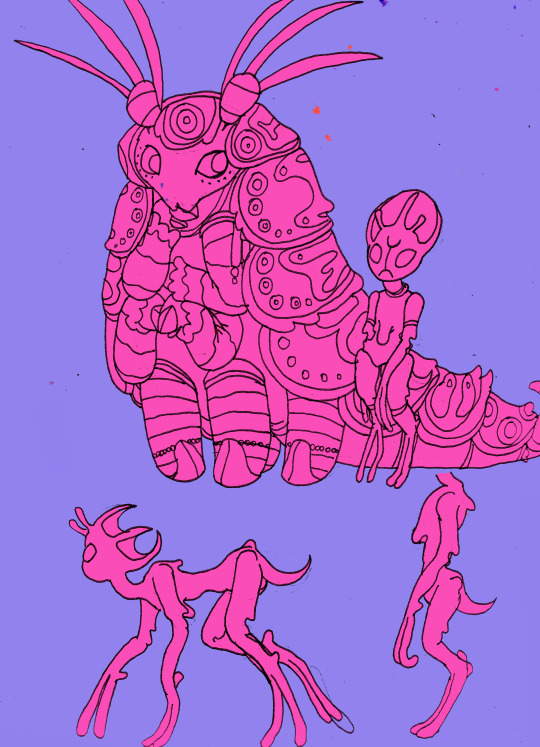
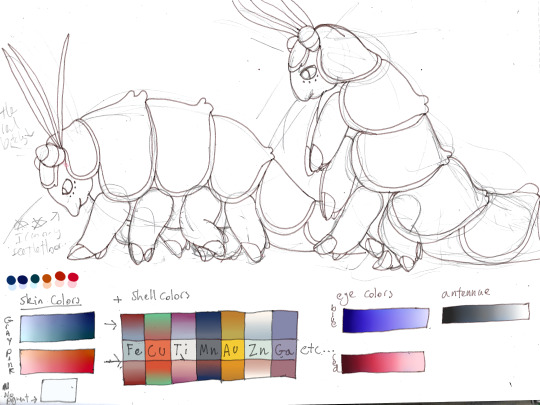
a collection of funny brainstorming doodles
first one is thinking a little bit about kkariko writing/symbology. atm, i'm focusing on rrikrik's cultural background, as kkariko are generally pretty diverse and live widespread on their home planet, which has resulted in a huge spectrum of cultural diversity. as for writing specifically, i was thinking that kkariko would probably find it best to use their "palps" to perform delicate dexterious tasks such as writing as they would have be more flexible than the exoskeleton coverings on their feet. for this script, i was thinking about a kkariko wrapping their palps in a soaked cloth and making long swooping marks on the page with them.
also thinking about the way kkariko and ki move. kkariko have four pairs of legs and for balance it would be better if they walked on two. however, i think they can run on all four pairs and stand up on one pair when threatening. their big long tail probably prevents them toppling over. as for ki... i haven't done as much thought. bipedal species are kinda tough because there's always the fear of just defaulting to human gait. i wanted ki to have super long arms and "fingers" though, so decided to give them a transitional gait for now. also look at soh's cute little tail. the off-model soh is really bad tho. but it shows the size comparision between the twos.
kkariko coloration. they have two main pigments on their bodies - one blue/gray and one pink. rika (their home planet) is very metal-rich and the metals which kkariko eat go to their shells, which take on different tones dependent on their diet. i was thinking about how these shell colors would interact with their base pigmentation as well as the effects of oxidization, as rika also has an oxygen rich atmosphere. i imagine that shells showing off rare metals and low levels of oxidization are a huge status symbol. for rrikrik, their diet is very varied in metals and they don't tend to have the luxury of staying inside, so their shell is patchy and covered in rust.
#alien species#oc#xenobiology#speculative biology#alien biology#kkariko tag#ki tag#sci fi#now you know that rrikrik doesnt take care of their shell and thats why its covered in patterns#i had a much better drawing of rrikrik soh AND a human but i havent finished it yet
44 notes
·
View notes
Note
So ironically your care tips for serviper inspired me to look into getting a zangoose any tips? mainly I want to know about any potential conflicts with other mons as when I try to look into that all i find is stuff about serviper and zangoose
General notes:
The Zangoose is a hot blooded pokemon and can be quite reactive, but has a good reputation for being healthy and sturdy, and can be quite loyal.
General care:
Zangoose are obligate carnivores, and have a strong prey drive. Care needs to be taken around small prey pokemon, particularly though with quick or jerky movements.
Though they can be quite active, particularly at night, zangoose may sleep up to 15 hours a day, and need quiet, dark resting spots to simulate burrows.
Zangoose sharpen their claws often, and good quality scratching posts or logs are VITAL. Otherwise they will turn to your furniture.
Zangoose have powerful immune systems and a near total immunity to poison. It's rare for these to show up at pokemon centres for anything other than battling injuries. These are not fussy and delicate creatures and they may try and eat carrion if not stopped. But don't fret too badly if they get into something they shouldn't. Zangoose are TOUGH.
Care rating: Green
Training:
Zangoose train well, and are pretty smart. They can be easily aggravated, and lose their cool. If they're getting frustrated, it's best to stop training for the day and do something calming. Zangoose seem to enjoy calming rhythmic motions, like watching the ocean or listening to wind in trees, and this is a good way to cool them off.
This line is very agile, and they LOVE agility training. Agility contests are becoming quite popular, and zangoose tend to hold most of the records.
Any and all training WILL go out the window if it catches wind of a seviper. Be on the lookout for sudden bristling of the fur and a sudden switch from its usual quadrupedal gait to a bipedal stance. Pokeball it IMMEDIATELY and leave the area. Though the venom can't hurt it, seviper have long fangs and a sharp bladed tail. Both of these pokemon can do SERIOUS damage to each other.
Because this behaviour cannot be trained out of them, they get a slightly higher ranking than they otherwise would get, as you can't afford to let your guard down.
Training rating: Orange
Safety:
Zangoose are surprisingly careful when they don't detect any seviper nearby, and are quite aware of where their claws are. Though I wouldn't leave toddlers and babies unsupervised, they seem to understand that children can be bothersome, and have a fair amount of patience. Though this is likely due to the fact zangoose kits are extremely loud, bitey and chaotic for their poor mothers. Even so, it's best to make sure you're always in the room with them.
Zangoose can be nippy when pressed, but they have quite strong tells when their temper is flaring up, flaring their hackles and emitting a low guttural hiss when annoyed. Quite frankly, a failure to give them space when they're being so unambiguously clear...
Well, that's on you.
Having said that, the absolute last place I would want to be is between a zangoose and a seviper if they spot each other. That's not something you can stop or train out of them. No amount of giving your zangoose space will stop it killing the local gym leaders ace for the crime of sunning itself in the park.
Safety rating: Orange
Overall ranking.
Though it can be somewhat testy, a well trained zangoose is a good fighter with relatively few needs beyond good food, exercise and a warm place to sleep. But the fact that you need to be constantly alert to avoid a bloody and brutal fight makes this a somewhat nerve wracking pokemon.
21 notes
·
View notes
Text

The Mystery of the Devil's Footprints
Sweeping an unyielding trail of up to 100 miles, they were found in fields and lanes, they scaled rooftops and jumped up drainpipes. They were undeterred by solid objects such as haystacks or walls and were undaunted by rivers.
The Devil’s Footprints, also known as The Devil’s Hoof Prints, were an extraordinary trail of imprints in the snow in southwest England that materialised over the course of the night of 8-9 February 1855. The prints looked as though they had been created by cloven hooves, but were, in all other respects, utterly inexplicable.
The cloven hoof shape of The Devil’s Footprints were said to resemble those of a donkey, but the gait was not that of a four-legged animal. They were believed to have been those of a bipedal, or two-legged, creature.
Each of The Devil’s Hoof Prints measured about 3 inches wide and 4 inches long, which is not dissimilar to that of a donkey’s. The ‘steps’ however, were comparatively small, spaced between 8 and 16 inches apart and in single file.
The Devil’s hoofprints were primarily found in the county of Devon, specifically surrounding the Exe Estuary, but some reports included Dorset as well. The exact route of The Devil’s Footprints is unclear. If all accounts are to be believed, the route was a circuitous one, from Exeter in the North to Torquay, 25 miles south and then 12 miles west of that to Totnes, not necessarily in that order. It took in a distance of 40 miles overall, but also meandered and wandered extensively within that area so could have covered up to 100 miles.
One of the most unusual aspects of The Devils Footprints were the places they were – and indeed were not – found. There were accounts of them skipping over areas or jumping from one place to another. Of being on rooftops, on either side of the River Exe, and also some solitary prints in fields. One farmer recounted The Devil’s Footprints stopping on one side of a haystack only to restart on the other, with the stack untouched.
The Times article of 16 February 1855 spoke of “A vast number of foot tracks of a most strange and mysterious description. The superstitious go so far as to believe that they are the marks of Satan himself.”
With the shape of the marks so resembling the Devil’s described cloven hooves, many were quick to ascribe the phenomenon to the Prince of Darkness. This was all the more sinister in conjunction with the myriad marks to and from doorsteps and circling homes and churches, creating rife speculation that He was combing the countryside for sinners.
A lack of contemporaneous evidence and witnesses means that it’s unlikely that the source of The Devil’s Footprints will ever be determined. What is certain is that the mystery has continued to fascinate any who come across it. And that, without a firm explanation, some will always believe that it was Satan who wandered Devon on that fateful night in 1855.
34 notes
·
View notes
Text

Compared to robots, human bodies are flexible, capable of fine movements, and can convert energy efficiently into movement. Drawing inspiration from human gait, researchers from Japan crafted a two-legged biohybrid robot by combining muscle tissues and artificial materials. Publishing on January 26 in the journal Matter, this method allows the robot to walk and pivot."
Research on biohybrid robots, which are a fusion of biology and mechanics, is recently attracting attention as a new field of robotics featuring biological function," says corresponding author Shoji Takeuchi of the University of Tokyo, Japan
"Using muscle as actuators allows us to build a compact robot and achieve efficient, silent movements with a soft touch."The research team's two-legged robot, an innovative bipedal design, builds on the legacy of biohybrid robots that take advantage of muscles.
Muscle tissues have driven biohybrid robots to crawl and swim straight forward and make turns -- but not sharp ones.
Yet, being able to pivot and make sharp turns is an essential feature for robots to avoid obstacles.
To build a nimbler robot with fine and delicate movements, the researchers designed a biohybrid robot that mimics human gait and operates in water.
The robot has a foam buoy top and weighted legs to help it stand straight underwater.
The skeleton of the robot is mainly made from silicone rubber that can bend and flex to conform to muscle movements.
The researchers then attached strips of lab-grown skeletal muscle tissues to the silicone rubber and each leg.
When the researchers zapped the muscle tissue with electricity, the muscle contracted, lifting the leg up. The heel of the leg then landed forward when the electricity dissipated.
By alternating the electric stimulation between the left and right leg every 5 seconds, the biohybrid robot successfully "walked" at the speed of 5.4 mm/min (0.002 mph). To turn, researchers repeatedly zapped the right leg every 5 seconds while the left leg served as an anchor.
The robot made a 90-degree left turn in 62 seconds. The findings showed that the muscle-driven bipedal robot can walk, stop, and make fine-tuned turning motions.
"Currently, we are manually moving a pair of electrodes to apply an electric field individually to the legs, which takes time," says Takeuchi.
"In the future, by integrating the electrodes into the robot, we expect to increase the speed more efficiently."
#sciencedaily#science#robotics#Biohybrid robotics#3d printing#Lab grown muscular tissue#Cultured muscular tissue
9 notes
·
View notes
Text
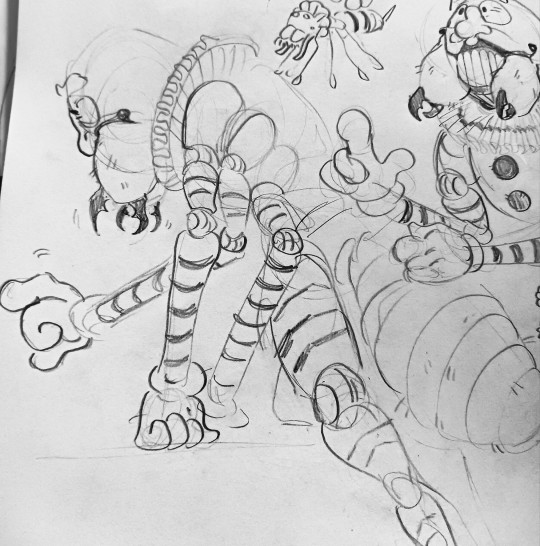
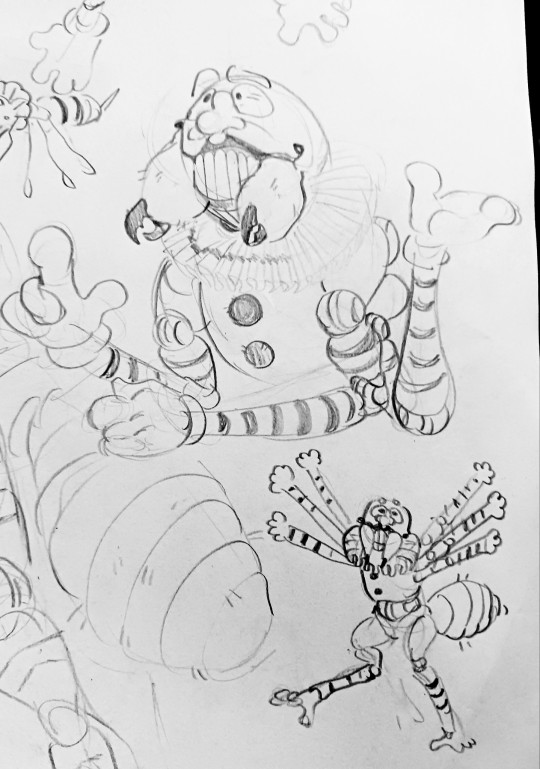

camel spider guy. just for @akikothefuzzball (and me) (i also really really like him)
Fun fact, this guy's actually particularly older than a lot of the other cast because he was made in 2016 during the clown panic. Ahh, capitalism. His popularity even after the panic has kept him in the cafe and he has undergone many, many upgrades since then.
Also, I've noticed that a LOT of the designs are bipedal. Sorry about that guys 💀 To circumvent this I've just decided that bipedalism is a begrudging option for them and whenever possible (or afterhours) they go on all 8's. It's simply better on their knees, since they're all super heavy. Camel bartender and tick vampire are the ones who frequently makes use of their octopodal gaits since they are the ones expected to stand the most.

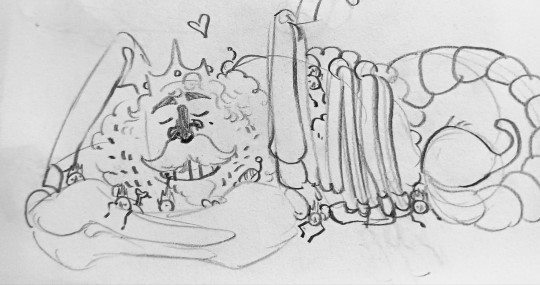
Another favorite of mine!! Scorpiones MM <3
He is rather arrogant but he does have a very big soft side for his Schizomida subjects. Originally allocated to the (newly redesigned) Dazzle whipscorpion MM, when Scorpiones came to town, he had no hands, just big pincers. The Schizomida were then allocated to him in order to make up for his lack of hands, but were also made en masse since they were expected to be destroyed frequently. However, under his care, only 1 has ever been destroyed. He's a very protective father
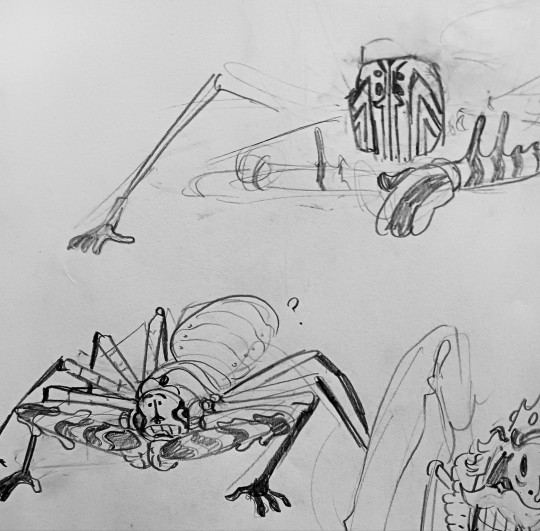
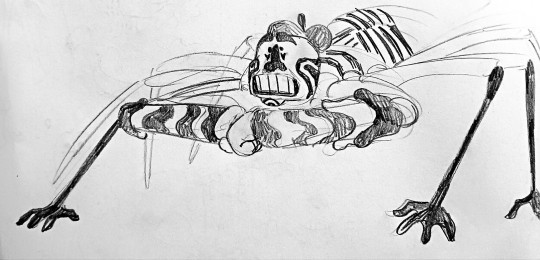
I didn't like how I made the amblipygi MM. I liked the mime concept a Little Bit but I made it bland. I wasn't able to completely draw it out but his design and name are derived from dazzle camouflage which I think would look really trippy on a robot.

bonus tiny caine. for u
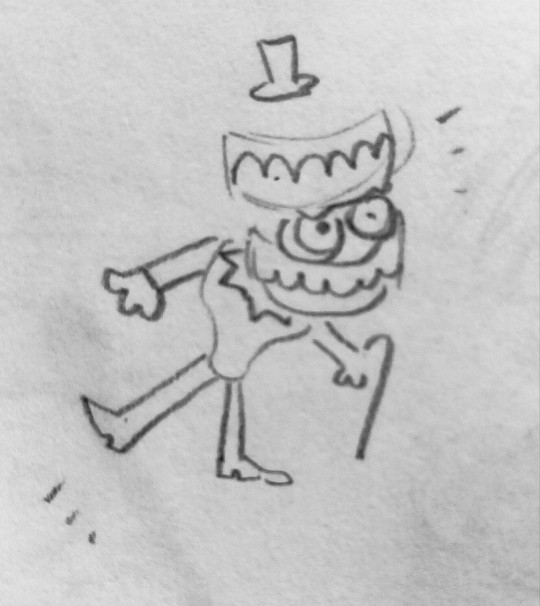
18 notes
·
View notes
Note
Could you try 40 and an ibvs ship of your choice?
I was debating between Chrevinstoph and Isward with this one, but I think it turned out well.
~~~~~
This was it. It seemed all of their messing around with demons and the supernatural had caught up to the group. All the pair could do is stand in stunned silence as they witness the chaotic symphony sung by the screams around them.
A seemingly constant shaking of the ground beneath them cracked the pavement until it could not hold the weight above it. When the ground reached its breaking point, an abyss opened, swallowing anything unfortunate enough to be above it. The houses went first, leaving massive gaping holes looking to go straight to hell judging by the red glow slowly raising to the surface.
The ground threatening to collapse underneath them was far from the most dangerous thing there. Smoke filled the air as the anything not consumed burned around them. Trees, cars, bodies, the living. Nothing was safe from the wildfire raging around them. Anything unclaimed by the inferno was taken out by the acidic air.
If by some miracle the environment didn’t kill you, the roaming beasts would. Even the bipedal ones had an inhuman gait about them. The moment they reached a survivor, they would be torn to shreds. Their nature could only be described as demonic.
Isaac silently sat on his on their personal island as he watched the chaos. With Edward’s strings and his ink, they had managed to create one safe fortress- from the environment at least. If one of the demons attacked…they definitely weren’t strong enough to hold their own.
“Guess this is it, huh.” Edward whispered. He sat next to Isaac, utterly defeated. “Never thought I’d be around to see the apocalypse.” He muttered.
Isaac nodded slightly. “Never thought I’d be spending it with you.” He responded simply. He didn’t know where Chris was. Probably with Nevin. Or dead. Or both. He didn’t care at this point. “Hey, Error, look at me.” He scooted closer to him. Might as well distract himself.
Edward blinked and turned to look at Isaac only for his eyes to widen as ashen lips pressed against his own. Isaac tasted terrible, but he doubted he was much better. His mouth fell agape as the other boy pulled away. “Why-“
“We’re going to die anyway. Figured I’d check one thing off my wishlist.” Isaac sighed and moved away once again. “Sorry. I probably should’ve asked.”
Edward hesitated before sighing. “No, you’re fine. I think…I’d like to kiss more. It did kind of feel good, even if you taste terrible.” He smirked at Isaac.
“Yeah, yeah, like you’re any better.” Isaac scoffed and tipped Edward’s head towards him. “Just kiss me already.”
“Fine, whatever Ink.” Edward grumbled before leaning down and locking their lips together.
Kiss after kiss was exchanged between the two as the world burned down around them. When they finally succumbed, it was peacefully. Smoke filled their lungs and they passed out pressed against each other.
23 notes
·
View notes
Note
in the lt werewolf au, i feel like cam&pal would be v skeptical of gideon's werewolf theory: wwyd if your new coworker is absolutely convinced that the weird wolf pack you've been tracking are actually sort of people (she finds a really sketchy clip of a werewolf transformation. they tell her to stop stalking the cute goth)
OG ask here!
HDSFHIUEIUF they WOULD..... they're paragons of facts and logic and supernatural transforming goth girls just don't fit in that!!
Other option: Cam and Pal have a sort of Mulder and Scully dynamic of one is a skeptic and one is a believer... personally I see Pal as being the believer, he's like well these wolves don't necessarily behave as expected.... maybe he has a library of supernatural creature/cryptid textbooks & sources. Cam, on the other hand, just wants to finish their data collection so she can get back to her spreadsheets
Pal: "Here, this paw print---the gait here is somewhat different from what we expect... the creature seems to be favoring its back legs, indicitive of perhaps a more bipedal nature"
Cam, quickly stuffing a granola bar into his mouth as she takes soil samples: "Indubitably, Warden."
#harrow werewolf au#ask#anon#SORRY FOR SITTING ON THIS FOR LIKE 2 WEEKS............. my bad#hope u still see it anon!!
19 notes
·
View notes